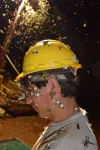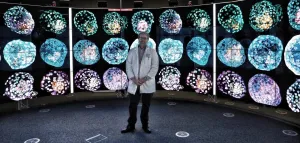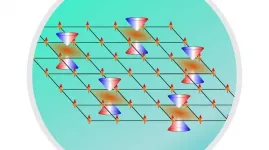INFORMATION:
The paper's other co-authors are Christian Ampudia Gatty, Universidad Nacional de la Amazonía Peruana, Facultad de Ciencias Biológicas; Juan Manuel Andia Navarro, Universidad Nacional Agraria La Molina, Museo de Entomología Klaus Raven Büller; Alfonso Alonso, SCBI; Reynaldo Linares-Palomino, SCBI; and Travis Longcore, UCLA Institute of the Environment and Sustainability.
About the Smithsonian's National Zoo and Conservation Biology Institute
The Smithsonian's National Zoo and Conservation Biology Institute leads the Smithsonian's global effort to save species, better understand ecosystems and train future generations of conservationists. As Washington, D.C.'s favorite destination for families, the Zoo connects visitors to amazing animals and the people working to save them. In Front Royal, Virginia, across the United States and in more than 30 countries worldwide, Smithsonian Conservation Biology Institute scientists and animal care experts tackle some of today's most complex conservation challenges by applying and sharing what they learn about animal behavior and reproduction, ecology, genetics, migration and conservation sustainability to save wildlife and habitats.
About Working Land and Seascapes
Working Land and Seascapes (WLS), an Action Area of the Smithsonian Conservation Commons, is an initiative that supports Smithsonian science in the service of people and nature. WLS scientists collaborate with partners and communities across 13 countries to conduct interdisciplinary research and inspire action that fosters healthy, resilient and productive landscapes and seascapes.
Mitigating impact of artificial light at night in tropical forests
New findings have major conservation implications for critical insects
2021-03-17
(Press-News.org) Artificial light at night (ALAN) is a major factor in global insect decline. In a paper published today in Insect Conservation and Diversity, Smithsonian Conservation Biology Institute (SCBI) scientists and partners found that using amber-colored filters to remove the blue spectra of light from "warm white" LED (light-emitting diode) lamps drastically reduces insect attraction to nocturnal lighting in a tropical forest. This is the first study to validate quantitative predictions of how lamp color affects insect attraction and provide clear recommendations to mitigate the negative impacts of ALAN on wildlife in rainforest ecosystems.
"While many people aren't necessarily fond of 'bugs,' their importance in our everyday lives is indisputable," said Jessica Deichmann, first author and research scientist with the Smithsonian Conservation Biology Institute and the Smithsonian Conservation Commons' Working Land and Seascapes Initiative. "The essential ecosystem services they provide are endangered by nighttime lighting. We shouldn't abandon using LED lights--their energy efficiency is second to none. Our research presents an alternative, especially for outdoor settings. If people everywhere take small steps in our homes, neighborhoods and commercial properties, we can reduce the negative impacts of sustainable LED lighting on wildlife."
In addition to using filtered LEDs that remove the blue light and appear more orange/amber in color, additional ways to support insects include the use of full cutoff fixtures, motion activators and dimmers to ensure light is used only when and where it is needed.
Insects play invaluable roles as pollinators of food plants, regulators of other insect pests, decomposers of waste and sources of food for other animals, like birds. Insects may be directly affected by lights when they suffer mortality from collisions with hot lamps, exhaustion or increased predation due to the attraction of predators and/or increased visibility. Insects affected by artificial lighting may also become disoriented or inactive, leading to a failure to reproduce, and consequently, a reduction of gene flow in the population.
The study was conducted in lowland rainforest in northern Peru inside a hydrocarbon (oil and gas) concession currently operated by GeoPark Peru. Scientists set light traps in 12 different locations with three different LED lamps with different spectra and a control (no light) to evaluate the number and composition of insects attracted to lamps during two different time periods at night.
Researchers identified 763 unique morphospecies among the greater than 15,000 insects captured across all samples, belonging to 18 different orders. Overall, significantly more morphospecies were captured in the white LED light traps than in either the yellow or amber-filtered traps or the control. Likewise, significantly more individual insects were captured in the white LED traps.
By using amber-filtered LEDs, the number of morphospecies attracted to the light was reduced by 34% and individual insects were reduced by nearly 60% as compared to white LED lamps with reduced blue-light content. In addition, among captured insect families known to contain important vectors of pathogens, bacteria or parasites, 45% of all individuals were captured at white lamps, 41% at yellow lamps and just 13% were found in amber lamp traps.
These results provide essential, tangible and actionable information on how to minimize ALAN, an unavoidable consequence of many types of infrastructure development and urbanization. The paper lays out specific management recommendations for new infrastructure projects in tropical forests that can also be applied to urban and rural residential areas.
ELSE PRESS RELEASES FROM THIS DATE:
Modelling speed-ups in nutrient-seeking bacteria
2021-03-17
Many bacteria swim towards nutrients by rotating the helix-shaped flagella attached to their bodies. As they move, the cells can either 'run' in a straight line, or 'tumble' by varying the rotational directions of their flagella, causing their paths to randomly change course. Through a process named 'chemotaxis,' bacteria can decrease their rate of tumbling at higher concentrations of nutrients, while maintaining their swimming speeds. In more hospitable environments like the gut, this helps them to seek out nutrients more easily. However, in more nutrient-sparse ...
'Time lost is brain lost'
2021-03-17
A new study involving UCLA researchers finds that mobile stroke units (MSUs) - state-of-the-art ambulances built to provide stroke patients with emergency neurological diagnosis and treatment prior to hospital arrival -- improve patient outcomes and lessen the chance for disability by delivering care faster than standard stroke care.
The UCLA Mobile Stroke Unit serves as a shared regional resource of LA County EMS Provider Agencies, taking patients to 15 different stroke center hospitals within 3 regions in Los Angeles County. The MSU carries a CT scanner that can directly image the brain and blood vessels in the field. UCLA was one of seven national mobile stroke unit programs to participate in the clinical trial, which was presented March 17 at the ...
Losing rivers
2021-03-17
Water is an ephemeral thing. It can emerge from an isolated spring, as if by magic, to birth a babbling brook. It can also course through a mighty river, seeping into the soil until all that remains downstream is a shady arroyo, the nearby trees offering the only hint of where the water has gone.
The interplay between surface water and groundwater is often overlooked by those who use this vital resource due to the difficulty of studying it. Assistant professors Scott Jasechko and Debra Perrone, of UC Santa Barbara, and their colleagues leveraged their enormous ...
Aspirin use may decrease ventilation, ICU admission and death in COVID-19 patients
2021-03-17
George Washington University researchers found low dose aspirin may reduce the need for mechanical ventilation, ICU admission and in-hospital mortality in hospitalized COVID-19 patients. Final results indicating the lung protective effects of aspirin were published today in Anesthesia & Analgesia.
"As we learned about the connection between blood clots and COVID-19, we knew that aspirin - used to prevent stroke and heart attack - could be important for COVID-19 patients," Jonathan Chow, MD, assistant professor of anesthesiology and critical care medicine and director of the Critical Care Anesthesiology ...
Study finds plants would grow well in solar cell greenhouses
2021-03-17
A recent study shows that lettuce can be grown in greenhouses that filter out wavelengths of light used to generate solar power, demonstrating the feasibility of using see-through solar panels in greenhouses to generate electricity.
"We were a little surprised - there was no real reduction in plant growth or health," says Heike Sederoff, co-corresponding author of the study and a professor of plant biology at North Carolina State University. "It means the idea of integrating transparent solar cells into greenhouses can be done."
Because plants do not use all of the wavelengths of light for photosynthesis, researchers have explored the idea of creating semi-transparent organic solar ...
Scientists create model of an early human embryo from skin cells
2021-03-17
AUSTRALIAN - LED INTERNATIONAL RESEARCH TEAM GENERATES THE FIRST MODEL OF EARLY HUMAN EMBRYOS FROM SKIN CELLS
In a discovery that will revolutionize research into the causes of early miscarriage, infertility and the study of early human development - an international team of scientists led by Monash University in Melbourne, Australia has generated a model of a human embryo from skin cells.
The team, led by Professor Jose Polo, has successfully reprogrammed these fibroblasts or skin cells into a 3-dimensional cellular structure that is morphologically and molecularly similar to human blastocysts. Called iBlastoids, these can be used to model the biology of ...
Racial/ethnic disparities in very preterm, preterm birth before, during COVID-19 pandemic
2021-03-17
What The Study Did: Racial and ethnic disparities in very preterm birth and preterm birth among 8,026 women were similar during the first wave of the COVID-19 pandemic in New York City compared with the same period the year prior in this observational study.
Authors: Teresa Janevic, Ph.D., M.P.H., of the Icahn School of Medicine at Mount Sinai in New York, is the corresponding author.
To access the embargoed study: Visit our For The Media website at this link https://media.jamanetwork.com/
(doi:10.1001/jamanetworkopen.2021.1816)
Editor's Note: The article includes conflict of interest and funding/support disclosures. Please see the article ...
AI method can detect precursors to cervical cancer
2021-03-17
Using artificial intelligence and mobile digital microscopy, researchers hope to create screening tools that can detect precursors to cervical cancer in women in resource-limited settings. A study led by researchers at Karolinska Institutet in Sweden now shows that AI screenings of pap smears carried out with portable scanners were comparable to analyses done by pathologists. The results are published in the journal JAMA Network Open.
"Our method enables us to more effectively discover and treat precursors to cervical cancer, especially in low-income countries, where there is a serious lack of skilled pathologists ...
Common antibiotic can safely be given to most surgery patients despite penicillin allergy
2021-03-17
BOSTON - Most surgical patients with a history of penicillin allergy can safely be given the guideline-recommended antibiotic cefazolin to prevent infection instead of several penicillin alternatives that are less effective and more expensive, according to a study conducted by Massachusetts General Hospital (MGH), the University of Colorado Anschutz Medical Campus and the University of Porto in Portugal. The researchers reported in JAMA Surgery that the frequency of allergies to both penicillins and cefazolin was so small that most patients should receive cefazolin regardless of their allergy history.
"Under current practice, ...
Magnetism meets topology on a superconductor's surface
2021-03-17
UPTON, NY--Electrons in a solid occupy distinct energy bands separated by gaps. Energy band gaps are an electronic "no man's land," an energy range where no electrons are allowed. Now, scientists studying a compound containing iron, tellurium, and selenium have found that an energy band gap opens at a point where two allowed energy bands intersect on the material's surface. They observed this unexpected electronic behavior when they cooled the material and probed its electronic structure with laser light. Their findings, reported in the Proceedings of the National Academy of Sciences, could have implications for future quantum information ...
LAST 30 PRESS RELEASES:
Air pollution exposure and birth weight
Obstructive sleep apnea risk and mental health conditions among older adults
How talking slows eye movements behind the wheel
The Ceramic Society of Japan’s Oxoate Ceramics Research Association launches new international book project
Heart-brain connection: international study reveals the role of the vagus nerve in keeping the heart young
Researchers identify Rb1 as a predictive biomarker for a new therapeutic strategy in some breast cancers
Survey reveals ethical gaps slowing AI adoption in pediatric surgery
Stimulant ADHD medications work differently than thought
AI overestimates how smart people are, according to HSE economists
HSE researchers create genome-wide map of quadruplexes
Scientists boost cell "powerhouses" to burn more calories
Automatic label checking: The missing step in making reliable medical AI
Low daily alcohol intake linked to 50% heightened mouth cancer risk in India
American Meteorological Society announces Rick Spinrad as 2026 President-Elect
Biomass-based carbon capture spotlighted in newly released global climate webinar recording
Illuminating invisible nano pollutants: advanced bioimaging tracks the full journey of emerging nanoscale contaminants in living systems
How does age affect recovery from spinal cord injury?
Novel AI tool offers prognosis for patients with head and neck cancer
Fathers’ microplastic exposure tied to their children’s metabolic problems
Research validates laboratory model for studying high-grade serous ovarian cancer
SIR 2026 delivers transformative breakthroughs in minimally invasive medicine to improve patient care
Stem Cell Reports most downloaded papers of 2025 highlight the breadth and impact of stem cell research
Oxford-led study estimates NHS spends around 3% of its primary and secondary care budget on the health impacts of heat and cold in England
A researcher’s long quest leads to a smart composite breakthrough
Urban wild bees act as “microbial sensors” of city health.
New study finds where you live affects recovery after a hip fracture
Forecasting the impact of fully automated vehicle adoption on US road traffic injuries
Alcohol-related hospitalizations from 2016 to 2022
Semaglutide and hospitalizations in patients with obesity and established cardiovascular disease
Researchers ‘listen in’ to embryo-mother interactions during implantation using a culture system replicating the womb lining
[Press-News.org] Mitigating impact of artificial light at night in tropical forestsNew findings have major conservation implications for critical insects




